
DOCUMENT RESUME
ED 281 369
FL 016 646
AUTHOR
.
Barnwell, David
TITLE
Syntactic and Morphological Errors of English
Speakers on the Spanish Past Tense .
PUB DATE
[87]
NOTE
24p.
PUB TYPE
Reports - Research/Technical (143)
EDRS PRICE
MF01/PC01 Plus Postage.
DESCRIPTORS
College Students; Comparative Analysis
Contrastive
Linguistics; *Error Patterns; Higher Education;
*Interference (Language); Morphology (Languages);
Second Language Learning; *Spanish; *Syntax; *Tenses
(Grammar); *Verbs; Writing (Compositio.1)
IDENTIFIERS
*Past Tense
ABSTRACT
A study examined the patterns of error in the
preterite and imperfect tenses in the written Spanish of native
English-speaking college studentg. Errors found in the midterm
examination were analyzed to determine whether they were due to
incorrect tense, incorrect form of the tense, or both. It was
predicted that many students would choose incorrect form or tense,
and many more would choose both. Results revealed that very few
answered with both incorrect tense and incorrect form, suggesting
that the choice of verb tense and knowledge of correct form are
largely independent of each other. In addition, interlingual errors
(choice of tense) were slightly more common than intralingual errors
(choice of verb form), supporting some earlier research results.
(MSE)
***********************************************************************
Reproductions supplied by EDRS are the best that can be made
from the original document.
***********************************************************************

SYNTACTIC AND MORPHOLOGICAL ERRORS OF ENGLISH SPEAKERS
ON THE SPANISH PAST TENSES
David Barnwell
Columbia University
-11.8.-DEPARTNENT OF EDUCATION
Office 04 Educational Research and Improvement
EDUCATIONAL RESOURCES INFORMATION
CENTER (ERIC)
Irf.frus document 1126 been
reproduced as
recetved_trom the person or organization
originating
it
0 Minor changes have been made to improve
reproduction quality.
Points of view or opinions stated
in thia docu-
ment do not
necessarily represent official
OERI position or policy
BEST COPY
AVAILABLE
12
"PERMISSION TO_REPRODUCE THIS
MATERIAL HAS BEEN GRANTED
BY
onvddi
TC1THE EDUCATIONAL RESOURCES
INFORMATION CENTER (ERIC)."
a
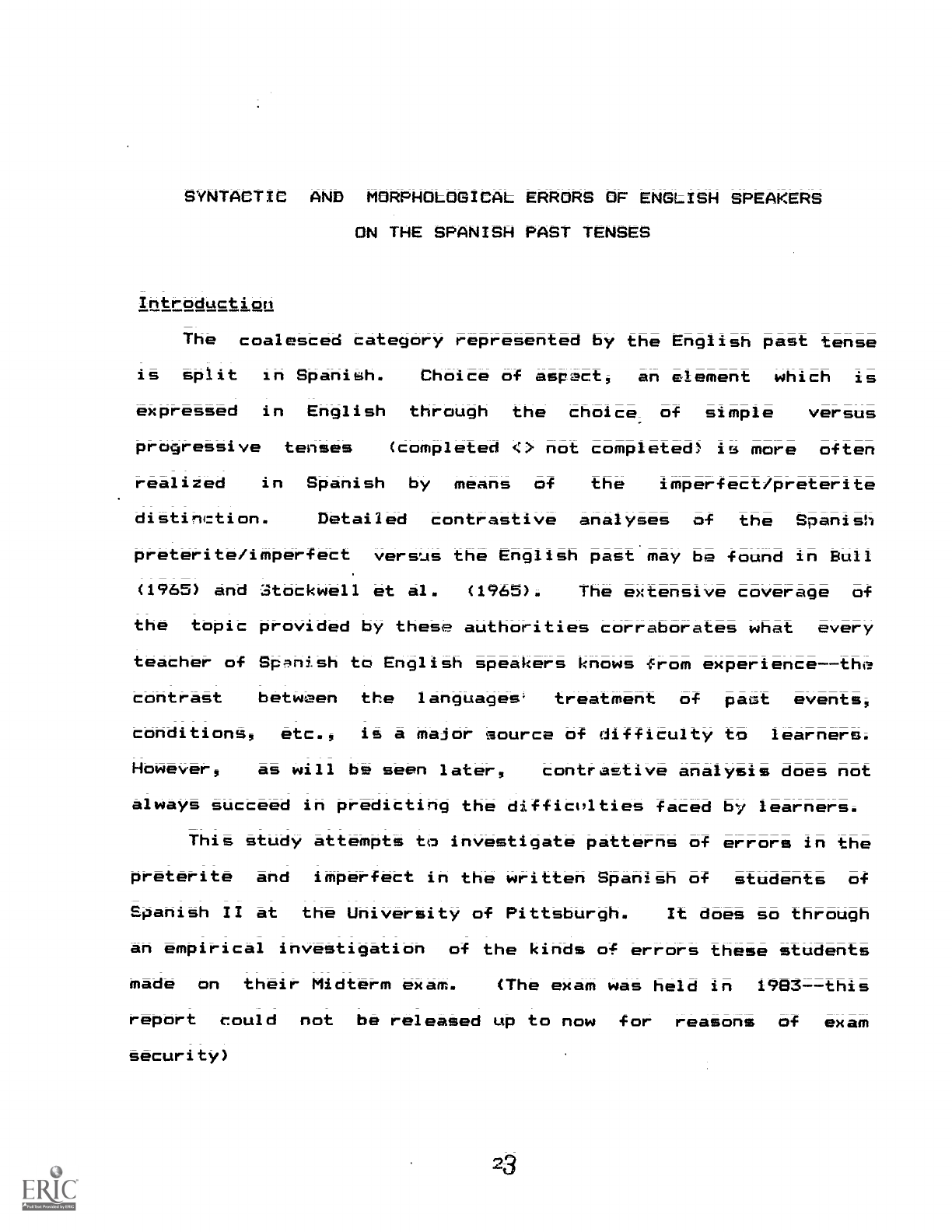
SYNTACTIC
AND
MORPHOLOGICAL ERRORS OF ENGLISH SPEAKERS
ON THE SPANISH PAST TENSES
Introduction
The
coalesced category represented by the English past tense
is
split
in Spanish.
Choice of aspect,
an element
which
is
expressed in
English through
the
choice_ of
simple
versus
progressive
tenses
(completed <> not completed) is more
often
realized
in Spanish
by means
of the
imperfect/preterite
distinction.
Detailed
contrastive
analyses
of
the Spanish
preterite/imperfect
versus the English past may be found in BuIl
(1965) And atockwell et al.
(1965).
The extensive coverage
of
the
topic provided by these authorities corraborates what
every
teacher of Spnish to English speakers knows from experience--the
contrast
between the
languages
treatment
of
peat events,
conditions'
etc.,
is a major source of difficulty to
learners.
However,
as will be seen later,
contrastive analysis does not
always succeed in predicting the difficulties faced by learners.
This study attempts to investigate patterns of errors in the
preterite
and
imperfect in the written Spanish of
students of
Epanish II at
the University of Pittsburgh.
It does so through
an empirical investigation
of the kinds of errors these students
Made on
their Midterm exam.
(The exam was held in
1983this
report
could
not
be released up to now
for reasons
of
exam
Security)
,3

It
is
probable
that different
instructors
explain the
Spanish tense system in different ways, but the basic explanation
put
forward in the text used at Pitt was likely to be the common
foundation
upon
which the subjects of this study
depended for
guidance in
this area.
So I consider it useful
to
cite the
exposition of
the preterite/imperfect with which
nearly
every
student of Spanish II included in this study might be expected to
be familiar:
EsGentially, the preterit
Views past events
etc.,
as noncontinuous,_ and the_imperfect_views
them
as continuous.
That is,
the preterit_ _is
used
to report events,
situations
etc.,
which
begin
or end--or both--at some time in the _past
which the speaker has in mind.
The imperfectp_on
the
other
hand,
is used
to _report
events,
situations
etc.,
which_neither begin_nor end_ at
the time the speaker is thinking of,
but
rather
which
have already begun and are in progress _or
existence
at this time...
Spanish
consistently
distinguishes
between
events in
progress and
events that begin and/or terminate,
by _choosing
the imperfect for the former and the preterit for
the latter.
English_may or may not
explicitly
make
the same distinction by_choosing particular
verb forms.
For example,
the expressions 'used
to' and 'was ---ing' clearly indicate habitual or
ongoing
events._
However, _in_all
other _cases
where Spanish
has_an imperfect, _English_has _a
simple
past tense_form
('had',_
'was', _'knew',
etc.) just as in all the cases. where Spanish
hat
the
preterit...
Another_ striking_ difference
between English
and
Spanish
is
that
English
sometimes
uses
completely
different
verbs tb
express distinctions that are_ made in_Spanish
by
choosing the
imperfect or
the
preterit.
_Fbr
example, the preterit of ocrocer is equivalent tb
'meet',
that is,
'begin an acquaintance', while
the
imperfect of
conocer
is
'know"be
_ _
acquainted with'.
Another_common_ verb that_ has
different English equivalents_in the preterit and
the imperfect is saber.
In the imperfect, saber
is 'know',
'have factual information',
while_ih
the
preterit
it is
'learn',
'helr',
'acquire
information'.
(Segreda & Harris, 1976, 105-106)

Thus,
it can be seen that students of Spanish must learn to
specify the context of past actions much more explicitly than
is
their
custom
in E:Iglish.
Generally, as Stockwell
and Bowen
(1965,
p. 284)
put
it,
the preterite/imperfect
demandrx
an
obligatory
choice in Spanish,
where there is often no choice in
English.
Indeed, it is for this reason that Stockwell and Bowen
place
this grammatical problem among those on the highest
level
of
their hierarchy of difficulty for English
speakers
learning
Spanish.
Empirical
evidence
of
the difficulty of
the
choice for
English speakers
is provided
by
Tran-Thi-Chau
(1975).
Restricting herself,
to a large extent, to Stockwell and Bowen's
work,
she
sought to determine the comparative difficulty of
33
different
Spanish
grammatical categories for English
speakers.
Her
findings,
based
upon the
responses
of 149
high-schooI
students
in Toronto,
enabled
her to set up
a hierarchy
of
difficulty of these 33 items.
Choice of imperfect/preterite was
the
second most difficult of the 33,
with an incorrect response
rate of
77%.
She
also assessed student
perceptions
of
the
diffictilty of the 33 items,
and found that choice of
imperfect/
preterite
was
considered the fourth most difficult category
by
her subjects.
In addition to the choice of imperfect/ preterite,
three
other categories
employed by Tran are
relevant
to the
present
study.
These
are Regular
Preterites, Irregular
Preterites,
and Regular Iffeerfects.
(It seems prof:P:131e that she
does
not list irregular imperfects because there are so
few of
them--only
three--in Spanish.
She does not explain her
reason

for this omission.)
It appears that under these categories
s e
listed errors made
in the form of the verb.
An
analysis of
students' errors and of their perceptions of relative
difficulty
revealed the following:
V. Wrong
O.D.
S.P.D.
Irreg.
Preteritet
44
23 17
Regul.
Preteritet
16
6
10
Regul.
Imperfects 53
26
21
Choice
of Tenses
77
32
30
0;D.=
Order of
difficulty of these itrims,
analysis of all 33 categories.
baSed uPon an
error-
S.P.D.= Student
Perception
of
difficulty of
these
items, in
regard
to
students'
opinions of
the
comparative
difficulty of all 33 categories.
Both
0.1)
and S.P.D.
figures rerresent positions on
a
scale from
1 to 33,
from
least
difficult to
most
difficult. Thus,
for instance, regular preterite forms
were
the
sixth least common
source of
errors,
while
choice of imperfect/preterite was the second most common.
Tran's
research did not specifically isolate the imperfect/
preterite as an object of study,
and,
as may already have
been
noticed,
the reader of her work must make guesses as to what her
figures actually represent.
Moreover,
the figure she cites for
regular
imperfects
(537. of
her
sample were
wrong on
this
category) seems extraordinarily high.
But it will be worthwhile
to
bear Tran's findings in mind in connection with the study now
to be described.
6
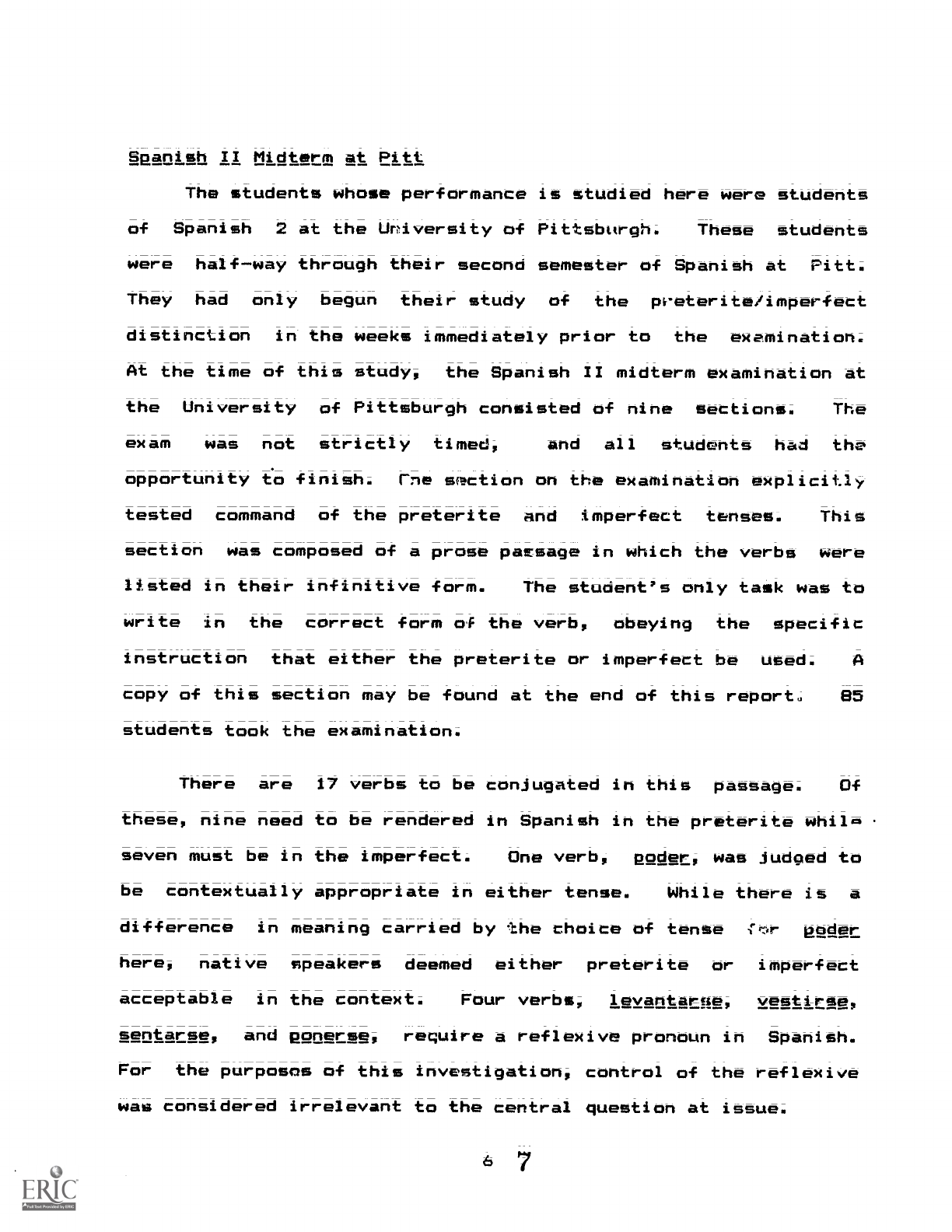
Spanish II Midterm at Pitt
The students whose performance is studied here were students
of
Spanish
2 at the Uriversity of Pittsburgh.
These
students
were
half-way through their second semester of Spanish at
Pitt.
They
had only
begun
their study
of
the preterite/imperfect
distinction
in the weeks immediately prior to
the
examination.
At the time of this study,
the Spanish II midterm examination at
the University
of Pittsburgh consisted of nine
sections.
The
exam
was not
strictly
timed, and
all
students
had th0
opportunity to finish.
rne section on the examination explicitly
tested
command of the preterite
and imperfect
tenses.
This
section
was composed of a prose passage in which the verbs
were
listed in their infinitive form.
The student's only task was to
write
in the
correct form of the verb,
obeying
the specific
instruction
that either the preterite or imperfect be
used.
A
copy of this section may be found at the end of this report.
85
students took the examination.
There
are
17 verbs to be conjugated in this
passage.
Of
these, nine need to be rendered in Spanish in the preterite while'
seven must be in the imperfect.
One verb,
Roder, was Judged to
be
contextually appropriate in either tense.
While there is
a
difference
in meaning carried by the choice of tense
;,:or Roder
here,
native speakers
deemed either
preterite
or imperfect
acceptable
in the context.
Four verbs;
levantarue,
vestkrse,
sentarse,
and Ronerse,
require a reflexive pronoun in
Spanish.
For
the purposos of this investigation, control of the reflexive
was considered irrelevant to the central question at issue.
7

Analysis of Errors
The total number of errors (T) was analyzed as +allows:
F:
Corr-ant tense choseni but written with an error in Form
Ns
Incorrect Tense chosen, but correct in form of that tense
Us
Blank entrieso
or forms which could not be assigned to
any
other category
Bs Entries
for which it was clear that the subject had
chosen
both
the
wrong tunse (imperfect/preterite)
and the
wrong
form of that tense;
The
responses:
following
tables
provide
a break-down
of student
Table 1
Total
No. of Entries
= 1445
(17 x 85)
Total
No. of Tense Choices
=
1360
(16 x 85)
Total
of optional choices
=
85
( 1 x
85)
Total
requiring preterite
=
765
(
9 x 85)
Total
requiring imperfect
=
595
( 7 x 85)
Total Errors on Entriec requiring Preterite
Ttital Errors on Entries requiring Imperfect
TOtal Errors
Table 2
S.rrors:
Preterite
Needed
Ti
284
Fi
134
(47%)
Ni
90
(32%)
Ui
51
(1R%)
B: 9
(3%)
= 284 (37%)
= 147
(24%)
=
431
(31%)
Imperfect
Total
Needed
147
12 (8%)
e4
(57%)
38
(26%)
13 (9%)
431
146
(34%)
174
(40%)
89
(21%)
22 (5%)
7
8

When
a particular entry is listed under U
above,
it is an
admitsion
that the
student was
trying
investigator was unable to
judge what the
to do.
So entries assigned to
category
U
comprised a variety of
most
common entries
inappropriate tenses,
these
cases,
it was
types.
Apart from spaces left blank% the
to be listed as U were
forms
of utterly
.g. present indicative or subjunctive.
In
impoasible to decide what the student
was
attempting ln
relation to the task
entey
is listed aS F above,
student was aware
the exact form of
under
B
above,
he had been
set.
When
an
a judgement had been made that
the
of which tense he had to use'
but did not know
the verb in this case.
Wheh an entrY i4 listed
it
has been judged tO be
attempt at
the
inappropriate tense of the two,
which was also
wrong in the form
of the verb in that inappropriate tense.
When an entry is listed
under N above,
it is clearly the correct form of the verb, in an
inappropriate tense.
It
might be suspected that a taxonomy such as this is
very
inaccurate,
since the only evidence we have for what the student
was
trying
to do is the word he wrote down on
the
examination
paper.
Since the tense is only recognizable morphologically, how
can we
assign
an entry to a tense when it
is
morphologically
incorrect?
In other words, the only way we
know that a student
chose
the
correct
tense is if he gave
the
correct
formx
an
incorrect
form, cannot be assigned with total confidence
to
any
tense.
8
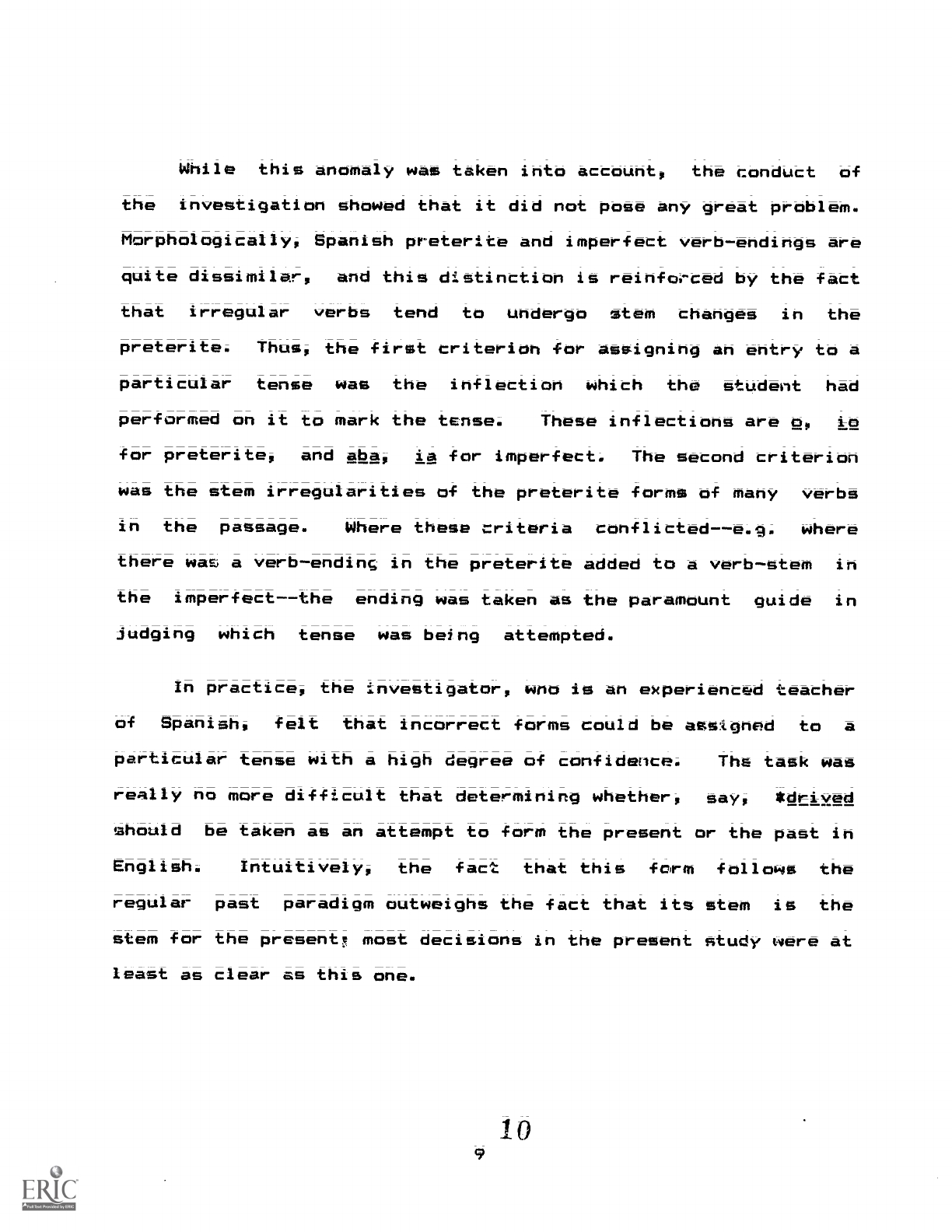
While
this anomaly was taken into account,
the conduct
the
investigation showed that it did not pose any great problem.
Morphologically, Spanish preterite and imperfect verb-endings are
quite dissimilar,
and this distinction is reinfo.-ced by the fact
that
irregular
verbs tend
to
undergo stem
changes in
the
preterite.
Thus, the first criterion for assigning an entry to a
particular
tense
was
the
inflection
which
the
student
had
performed on it to mark the tense.
These inflections are op
ko
for preterite,
and aba,
ia for imperfect
The second criterion
was the stem irregularities of the preterite forms of many
verbs
in the
passage.
Where these criteria conflictede.g.
where
there was a verb-endins in the preterite added to a verb-stem
in
the
imperfect--the
ending was taken as the paramount
guide
in
judging
which
tense
was being
attempted.
In practice, the investigator, wno is an experienced teacher
of Spanish*
felt
that incorrect forms could be assigned
to
a
particular tense with a high degree of confidence;
Ths task was
really no more difficult that determining whether,
say,
*driyed
should
be taken as an attempt to form the present or the past in
English. Intuitively,
the
fact
that this
form
follows the
regular
past
paradigm outweighs the fact that its stem
is
the
stem for the present
most decisions in the present study were at
least as clear as this one.
10
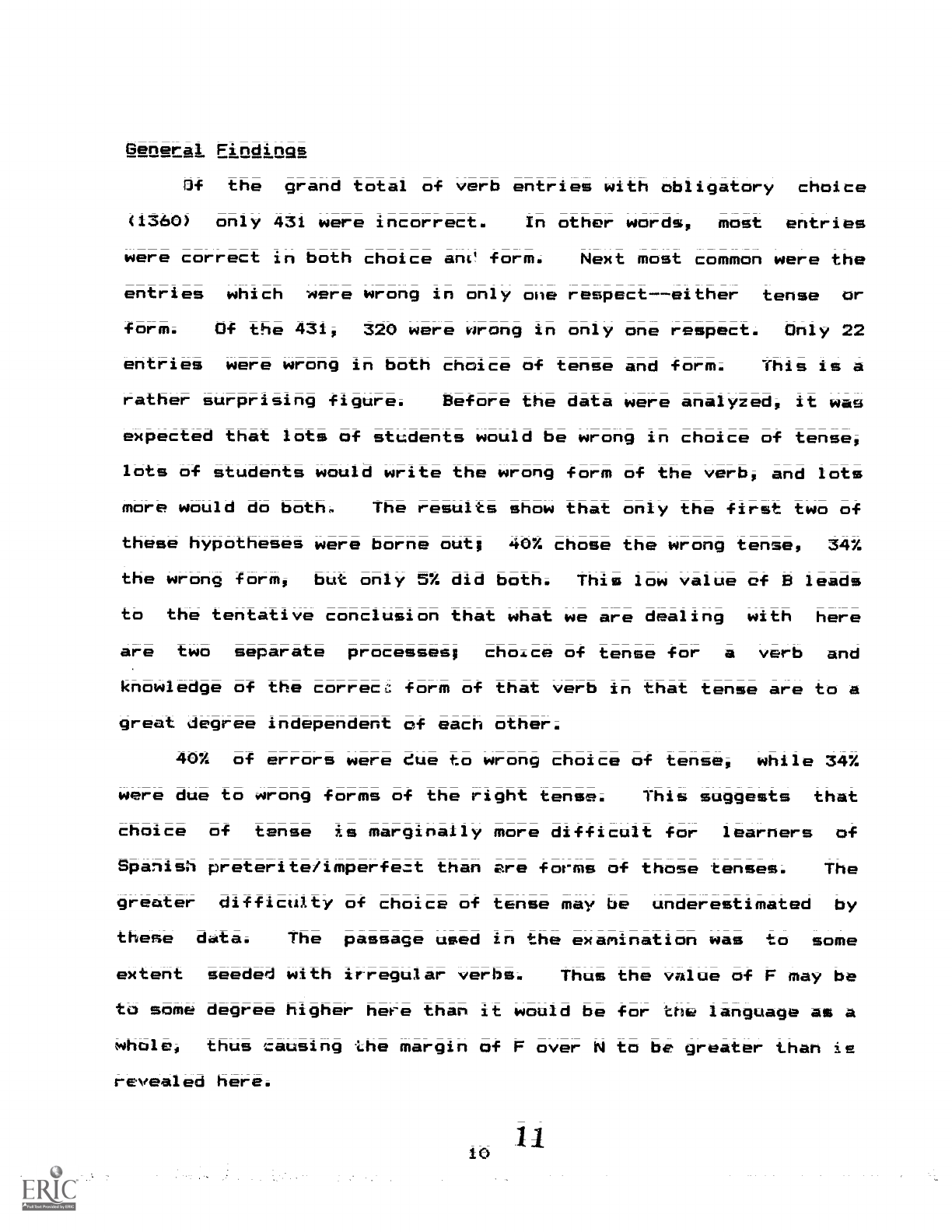
General Findings
Of
the
grand total of verb entries with obligatory
choice
(1360)
only 431 were incorrect.
In other words,
most
entries
were correct in both choice ane form.
Next most common were the
entries
which
were wrong in only oue respect--either
tense
or
form.
Of the 431,
320 were wrong in only one respect.
Only 22
entries
were wrong in both choice of tense and form.
This is a
rather surprising figure.
Before the data were analyzed, it was
expected that lots of students would be wrong in choice of tense,
lots 04 students would write the wrong form of the verb, and lots
more would do both.
The results show that only the first two of
these hypotheses were borne out;
40% chose the wrong tense,
34%
the wrong form,
but only 5% did both.
This low value of B leads
to
the tentative conclusion that what we are dealing
with
here
are
two separate
processes;
choxce of tense for
a verb
and
knowledge of the correci: form of that verb in that tense are to a
great degree independent of each other.
40%
of errors were due to wrong choice of tense,
while 347.
were due to wrong forms of the right tense.
This suggests
that
choice
of tense
is marginally more difficult for
learners of
Spanish preterite/imperfect than are forms of those tenses.
The
greater
difficulty of choice of tense may be
underestimated
by
thene
data.
The
passage used in the examination was
to
some
extent
seeded with irregular verbs.
Thus the value of F may be
to some degree higher here than it would be for the language as a
whole,
thus causing the margin of F over N to be greater than is
revealed here.
10
11

Indkvi-dual Verbs
A discussion of the data en masse is of limited utility.
We
can come
to a
much better
understanding
of
learner's
'transitional
competence
(Richards 1974)
if we
examine
responses for each verb discretely.
For this reason,
responses
for each particular verb were analyzed,
and the most interesting
findings
are given below.
Verbs are listed here as regular
or
irregular;
this
applies to regularity in the tense required
in
the
context of the passage,
not to perfect regularity
in
all
passible
tenses of Spanish.
It should be remembered that
1=85
for all 17 of
1
1. levanto
these verbs.
Regu/ar Preterite
F= 2
N= 7
There is no striking pattern here.
As might
be
Li=
6
expected, the form of thit regular preterite did
13= 1
not
cause
much
difficulty.
Four of
unrecognizable
entries were in the present
the
tense
2. haci-a
forms.
Regular Imperfect
F= 1
The value of U is very
high,
COn5titUtin0 the
14=
1
highest proportion fOr U 'Lb be found f or any verb.
U=11
Analysis of entries classified Under U ShoWed
no
B= 0
clear patternr but most appeared to be composed by
analogy with irregular tenSet Of this verb (e.g.
Preseilt Indicative,
Future) or bY confusion
with
fortat of another verb, haber.
12
11

3. estaba
Regular Imperfect
F= I As expected,
a very Iow value for F
A rather
N= 3
high proportion of the total- errors were of
type
U= 6
U,
but these did not fall into any pattern.
The
B= 2
very Iow value of F is typical of those found
on
the
imperfects in this study.
These cast
great
doubt
on the reliability of Tran's rate of
error
(53%) for regular imperfects.
4.
vistio
Irregular Preterite
F=43 This verb is one of a small group of Spanish verbs
N= 1
whose stem-voweI is raised in the preterite. 30
U= 4 of
the incorrect forms were modelled
on the
El= 1
infinitive stem vestir, making its preterite form
regular *vestig.
Other common errors of form (4
of each) were *vest( and *visto.
The former is the correct first
person
preterite,
while the latter seems to stem from a
belief
that the verb is of the -ar conjugation,
for which the preterite
ending is -o.
Visto is also the perfect participle of
another
verb
ver (to see) and it is conceivable that this also
produces
interference.
In any case, vistig was the verb which occasioned
the most incorrect forms, leading to the suggestion that a slight
irregularity
(i for e) is trickier than a
gross irregularity.
Noteworthy also for this verb was the very low value for N.
12 13
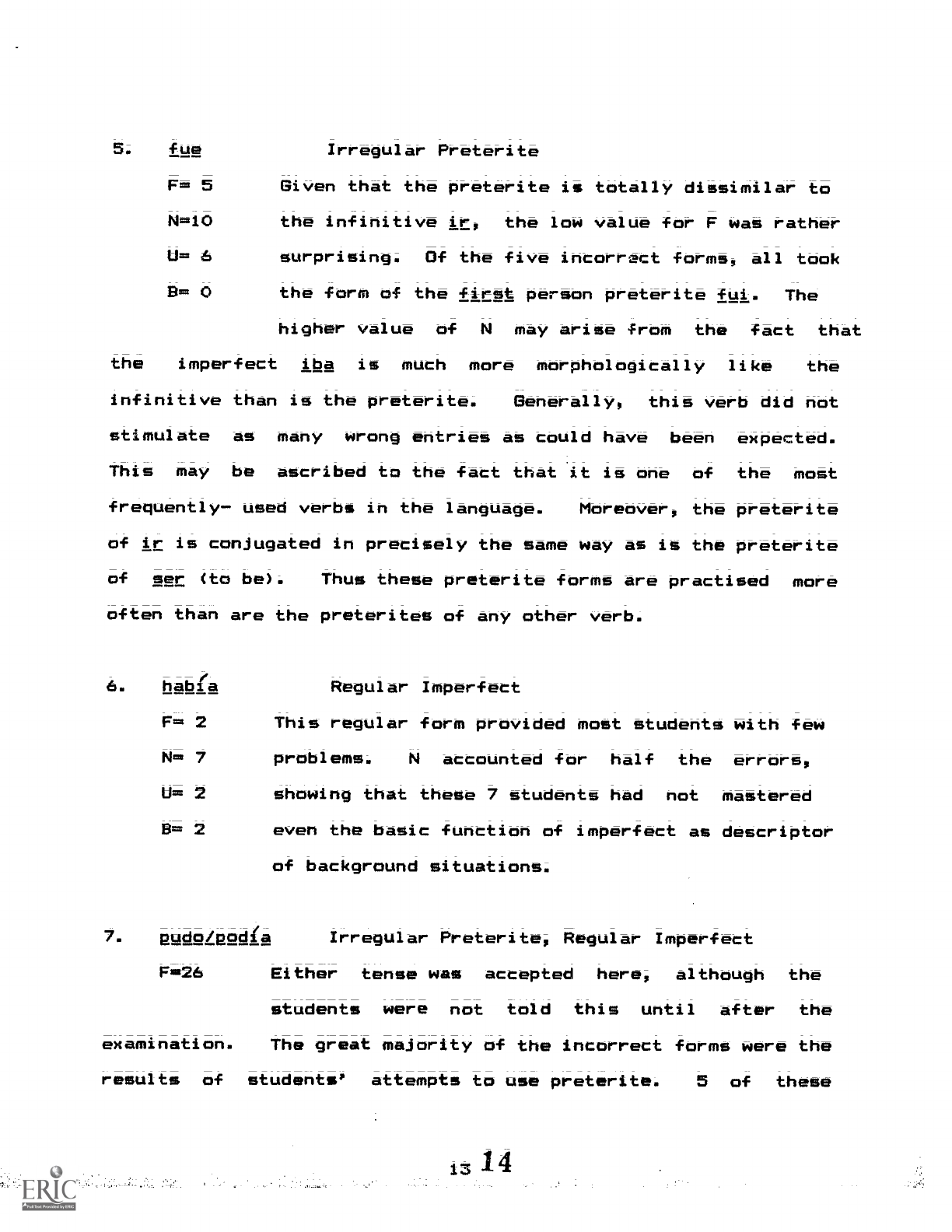
fue
F= 5
N=10
Irregular Preterite
Given that the preterite is totally dissimilar to
the infinitive ir,
the low value for F was rather
U= 6
surprising.
Of the five incorrect formt, all took
El= 0
the form of the first person preterite fui.
The
higher value
of
N
may arise from
the
fect
that
the
imperfect
iba is
much
more
morphologically
like
the
infinitive than is the preterite.
Generally,
this verb did not
stimulate as
many
wrong entries as could have
been
expected.
This
may
be
ascribed to the fact that it is one
of
the matt
frequently- used verbs in the language.
Moreover, the preterite
of ir is conjugated in precisely the same way as is the preterite
of
ser (to be).
Thus these preterite forms are practised
more
often than are the preterites of any other verb.
6.
habia
F= 2
N= 7
U= 2
El= 2
Regular Imperfect
This regular form provided most students with few
problems.
N
accounted for
half
the
errort,
showing that these 7 students had
not
mastered
even the basic function of imperfect as descriptor
of background situations.
7.
Rad° Ro
Irregular Preterite, Regular Imperfect
F=26
Either tense was
accepted here,
although the
students
were
not told this
until
after the
examination.
The great majority of the incorrect forms were the
results
of
students'
attempts to use preterite.
5 of these
1314
,

showed
*audiothe student
knew that
the verb was of the
irregular
group whose stem-vowels are raised in
the preterite,
but
he didn't
know that
moder is
doubly
irregular in the
preterite, since it takes the ending o (unstressed) which is mcr-e
like the o (stressed) of -ar verbs.
There were four first person
preterite pude,
and four first person preterite of another
verb
moner.
The
total number of errors (F=26) represents 31% of the
85 attempts.
This is striking in its equivalence to the rate of
errors of all types (31%) for the examination as a whole.
8. salio
Regular Preterite
F= 6
Only
six entries gave the wrong
form of
this
N= 6 regular verb.
Of these,
four used
the
first
U 3
person preterite sali.
B= 0
9. esaeraba
F= 1
N=25
Regular Imperfect
By far the greatest source of
error here was
choice of tense.
The context here clearly demands
U= 5
the imperfect, so it is regrettable that we have no
B= 2
way
of ascertaining why 25 students
chose
the
preterite.
Possible sources of error include the
fact
that a literal translation of the Spanish to English
would
result
in a rather strange phrase in English--"he expected it in
the be,x"--and,
in addition,
that the word buzon
was probably
unknoWn to the majority of the students.
14 15

10, delatla
Regular Imperfect
F= 3
A similar pattern of errors to the previous verb,
N=17
though not as striking.
Again,
it it
difficult
U= 4
B= 1
11.
sento
to see why 17 students chose the preterite.
It is
unlikely that the high rates of errors in
choice
of tense for
verbs 9 and 10
would have been
predicted by a contrastive analysis.
Regular Peeteeit
F=35 Why
did so many students give the wrong form
of
N= 6
this regular verb?
Analysis
of errors Shows
U= 5
two main types.
17 students wrote
*stentop they
B= 1
knew that the dipthongization of stressed
0 is
widespread
in Spanish,
but they
overgeneralized
this to embrace the unstressed e of the preterite.
The majority
of
the
remaining errors revealed confusion
with another
verb
sentir (to feel, regret).
This latter verb is of the type whose
stem-vowel is raised in the preterite,
and many of the incorrect
forms entered for sentar showed
for e in the stem.
12. leyg
F= 4
N= 3
U= 4
B= 0
Regular Preterite
As far
as the
subjects
of this study
were
concerned, this was the easiest verb on the entire
examination,
total errors
= 11. All
four
incorrect
forms exhibited
the firat
person
preterite lei.

13. interesaba(n)
Regular Imperfect
F= 2
N B
U= 5
Strictly, this verb should be written in the
plural, since the subject of the Spanish sentence
is incidentes.
However, it was decided to accept
13= 0
both singular and plural as correct, since the
students
had not yet practised
syntactical
patterns of
this
typei
Very few of
the entries,
(correct
or
incorrect) showed an attempt to
use the plural.
14.
Ruso
Irregular Preterite
F=16 The high proportion of unrecognizable
forms was
N= 3
due to apparent confusion with another verb Roderi
U=11
Of the 16 identifiable errors,
7 took the form of
13= 1
first person preterite.
The remaining 9
wrong-
form entries revealed 7 different kinds of errors.
15.
suRo
Irregular Preterite
F 10
The subjects had to make a fairly sophisticated
N=40
choice here.
The context of the passage demanded
U= 5 that
the preterite
(found out,
realized)
be
13= 2
employed rather than the imperfect (knew).
Nearly
hal; the students made the wrong decision on this
This
supports the contrastivists' expectation that the
greatest
difficulties
will arise when what is expressed lexically in
one
language
is expressed syntactically on anotheri
(It would be
very
interesting
to see how great this problem is
for Spanish
speakers learning English).
Of the ten errors in form, six were the
result of treating the verb as regular, and thus writing *sabio.
16 17

16. 1-1-ovia
Regular Imperfect
F= 2
It is very noticeable that such a high number of
N=23
students (23+5=28) chose to put this verb in the
U= 5
preterite.
This is despite the fact that this it
B= 5
one of the few verbs in the passage for Which the
English
equivalents closely parallel the Spanish.
Thus Spanish preterite would be rendered by English 'i-t
rAined',
while imperfect
would be translated as 'i-t
was ratning'. A
contre.stive
analysis would
be very unlikely
to predict that
students would choose the preterite to express 'it was
raining',
yet
this is
precisely what one-third of the students
in this
sample did.
17.
volvio
F=13
N=I2
U= 7
B= 3
Regular Preterite
Of the 13 incorrect forms,
the most common error
was to overgeneralize dipthongization of stressed
o to unstressed o.
Thus six students wrote
*vuelvio.
Discussion of Errors
The isolation
of individual verbs shows that the
finding
for the totality of the data--that N errors were marginaLly
more
common than
F errors--masks violent oscillations
in particlur
cases.
Thus for vistio,
for example, F=43, N=1, while for supo
F=101 N=40i
As might have been expected, F-type errors were most
numerous on irregular preterites, where the average for F was 12;
There
were very few errors of form on the imperfect
verbs; the

average
for each was F=1.7,
and in the case of three verbs F=1.
Of the three kinds of verb, the value of F for regular preterites
seems strangely high.
There is, on the surface, no reason why a
regular preterite should be so much more difficult than a regular
imperfect.
But this
high
value for F was accounted
for
by
examining all the incorrect responses, and it provided one of the
most
interesting findings of this study.
The data show
fairly
conclusively that it is not so much whether a verb is regular
or
irregular that counts, but rather whether a student suspects that
it may be irregular.
This suspicion is based on two factors:
1)
The
verb is of a stem-changing
type. Thewe may
be
viewed by students as "irregular" e.g.
sentar, volver.
2)
The verb
is confused
with other
verbs that
are
irregular, either in the preterite or in other tenses e.g. goder,
poner.
It should
be
stressed
that this similarity
is
morphological alone; there was no sign of any lexical or semantic
confusion.
Thus,
irregularites
in
the system of the target language
have a kind of spillover effect.
Awareness that some verbs
are
irregular causes other verbs to be treated as irregular;
just as
the regular paradigms are overgeneralized,
so also are irregular
inflections.
Errors
of this
type
must be
classified
as
intralingual, and seemed to result from a strategy of learning.
There
were a
number of traces
of pedagogically
induced
errors.
It
was
noticed that in many cases
the first
person
preterite
was given.
This trend could not be discerned in
the
18
19

case of the imperfect forms,
since first and third persons
are
identical
fn this tense;
indeed this is one of the reasons
why
the imperfect
forms
were so much easier
than the
preterite.
There
was also a certain amount of interference from the present
tense visible.
Both theme types of errors may result from
the
way the language is presented to the learner.
A large proportion
of
responses in drills arri free conversation in class will be in
the first person and/or the present tense.
These forms thus have
primacy
over
others.
Conclusion
This study was prompted by the desire to see whether English
speakers
luarning
Spanish
encountered
greater difficulty
in
choosing the appropriate imperfect/preterite tense or in learning
the correct forms of verbs in these tenses.
To u me ext:Pnt thit
distinction obeys the formula
interlingual/intralingual.
Verbs
describing
the past in Spanish are more marked--for aspect--than
is usually the z:ase in English.
Errors in the forms of
Spanish
verbs
are
a function of irregularities within
Spanish
itself.
While the
study' threw up a lot of interesting
information en
eassant,
no
firm
answer was obtained to the
central
question
investigated.
Tran's research mentioned earlier enabled her
to
categorize
interlingual
errors
as accounting for
51% of
the
total, with
intralingual
errors marking up 29%.
The present
study,
though not exhibiting such a great difference,
supportel
Tran
in
finding interlingual errors (40%) to be
somewhat
more
common than intralingual errors (34%).
Yet this cannot be taken
19
20

as a justification of procedures of contrastive analysis, for the
study revealed a significant number of cases where rate of
error
could
not have been
predicted on
the basis of similarity/
disSimilarity to English.

Appendixs Text Used in Examination
2122

SPANISH 2, KIDTERM EXNM
III.
InstruCtions:
Write in the appropriate forms
of the verbs in parentheses
to render the following
sentences into a correct
paragraph in_Spanish._ Use
the blanks to the tight.
Uge oniz past tense (preterite
and iriperfzet).
Juan (1-1evaterSe)
a las seis.
1.
;2-HacEr) frio y el cielo
(3-estar)
2;
3.
cubierto de nubes.
(4-Vestirse ) y
4.
(5-it) A IA cricina.
Como no
5.
(6-haber) ni Pan ni huevosi
no
6.
(7=podet) preparar el dzsayuno.
7.
(8--,Salir) a buscar el
petiodico,
lo (9-esperar)
en el ht0.6n dOnde
S.
9;
siempre lo (I0-dejar) el
mUchacho.
10.
(11=Sentatse) y (12-leer) el
11;
peri6dico desde el ptiacipio
haste
el final, con elweptiCA
de la Cecil-lice
social.
Nunca le (13=inteteSar) Ica
13.
incidenteg de la Vida SOCial.
Luego
14.
(14-ponetse) la chaqueta.
(15-Saber)
15.
que (16=116Ver) y (17-volver).para
16.
AI paragua
.
17.
.69.0646;
Ant,Jr.

References
Bulil William.
1965.
Spanish
or teacherszapplied linguistics.
New York; John Wiley.
Richards,
lack C.
1974.
Error analysis;perspectives an second
languase acquisition.
London]Longman.
Segreda,
Gui.lermc, anl James Ha..-rs.
1976.
Spardsha Listening
Speaking Readins Writing.
New Yorkp Harcourt Brace Jovanovich.
Stockwell,
R.P,_ and
J.D.
Bowen.
1965.
The
grammatical
structures of
English
nd
panish.
Chicago;
University of
Chicago Press.
Tran-Thi-Chau.
1975.
Error analyttis, contrastive analysis, and
students'
percepticni
a study of difficulty in second
language
learning. IRAL,
13, 2, 119-44.
2 4
22
